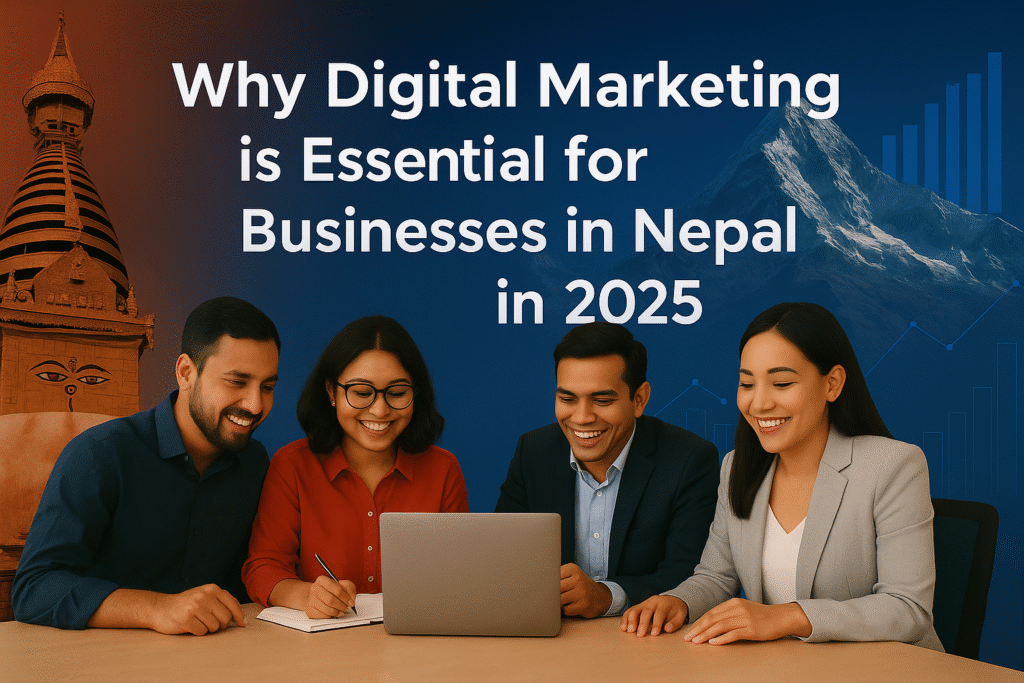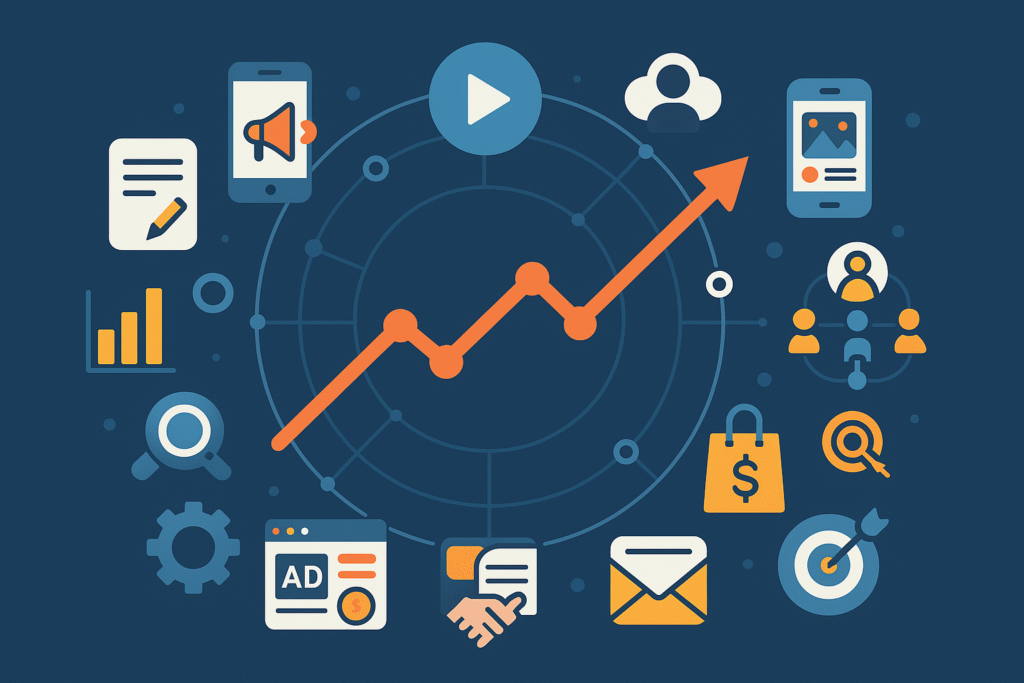Why Digital Marketing is Essential for Businesses in Nepal in 2025
“Go Digital. Grow Smarter. Succeed in Nepal.” In 2025, digital marketing will be a necessity for business success in Nepal. With over 16.5 million active internet users and 25+ million mobile data users, the digital space is where Nepali consumers search, compare, and shop. Platforms like Google, Facebook, YouTube, and Instagram are driving buying decisions daily. Businesses that invest in digital marketing in Nepal gain visibility, attract more customers, and build lasting brand trust. Effective tools such as SEO, social media marketing, content marketing, and online ads allow businesses to reach their audience with precision and impact. Whether you’re a local startup or a growing enterprise, digital marketing offers measurable results, affordable campaigns, and strong customer engagement. As Nepal’s digital economy expands, going digital is the key to staying relevant and competitive. The Digital Revolution in Nepal Nepal’s digital ecosystem is undergoing a remarkable transformation. According to recent data, approximately 60% of Nepal’s population is now online, driven by affordable smartphones, widespread internet access, and government-backed digitization initiatives. The Himalayan Times (2025) reports that 96% of internet users in Nepal access the web via smartphones, underscoring the country’s mobile-first orientation. This shift has profound implications for businesses, as consumers increasingly rely on digital platforms for information, shopping, and entertainment. The rise of e-commerce, fueled by platforms like Daraz and SastoDeal, and the growing popularity of social media platforms such as Facebook, Instagram, and TikTok, have reshaped consumer behavior. Businesses that fail to establish a strong online presence risk being left behind in a market where digital engagement is becoming the norm. Digital marketing offers Nepali businesses a cost-effective, measurable, and scalable way to tap into this growing online audience. Why Digital Marketing Matters in Nepal Cost-Effectiveness for Businesses of All SizesUnlike traditional marketing methods such as print or television ads, digital marketing requires lower investment while delivering higher returns. For small and medium-sized enterprises (SMEs) in Nepal, which form the backbone of the economy, digital marketing provides an affordable way to compete with larger players. Tools like social media advertising and SEO allow businesses to reach targeted audiences without the hefty budgets required for traditional campaigns. Global and Local ReachDigital marketing transcends geographical boundaries, enabling Nepali businesses to reach both local and international audiences. For instance, a boutique in Kathmandu can use Instagram to showcase its products to customers in Pokhara or even overseas. Local SEO strategies, such as optimizing for keywords like “best café in Kathmandu,” ensure businesses attract nearby customers, while global campaigns can target the Nepali diaspora or international markets. Measurable Results and Data-Driven DecisionsDigital marketing offers unparalleled analytics, allowing businesses to track performance in real-time. Tools like Google Analytics, SEMrush, and social media insights provide data on website traffic, user behavior, and campaign effectiveness. This enables Nepali businesses to refine their strategies, optimize budgets, and focus on what works, ensuring a high return on investment (ROI). Enhanced Customer EngagementDigital platforms facilitate direct interaction with customers, fostering trust and loyalty. Through social media, email marketing, and personalized content, businesses can engage with their audience in meaningful ways. For example, a travel agency in Pokhara can share trekking guides on its blog, respond to customer queries on Facebook, or send personalized offers via email, creating a seamless customer experience. Competitive Advantage in a Digital-First MarketAs more Nepali businesses embrace digital transformation, those that lag behind risk losing market share. A robust digital marketing strategy ensures businesses remain visible and relevant in a crowded marketplace. For instance, optimizing a website for search engines can help a local retailer outrank competitors, driving more traffic and sales. Key Digital Marketing Strategies for Nepali Businesses in 2025 To thrive in Nepal’s dynamic digital landscape, businesses must adopt a multi-channel approach that leverages the latest trends and technologies. Below are the key digital marketing strategies that are essential for success in 2025. 1. Search Engine Optimization (SEO) SEO is the cornerstone of digital marketing, enabling businesses to rank higher on search engines like Google, which dominates 96.23% of Nepal’s search engine market (StatCounter, 2025). With more Nepalis turning to Google to find products and services, SEO is critical for increasing visibility and driving organic traffic. Why SEO is Crucial in Nepal Local SEO for Regional Targeting: Local SEO is particularly important for businesses targeting specific regions, such as Kathmandu, Pokhara, or Biratnagar. Optimizing for location-based keywords like “SEO services in Kathmandu” or “restaurants in Pokhara” ensures businesses appear in local search results. Tools like Google My Business enhance visibility by displaying business details, reviews, and locations on Google Maps. Mobile-First Optimization: Given Nepal’s mobile-first market, websites must be responsive, fast-loading, and optimized for mobile devices. Google’s mobile-first indexing prioritizes the mobile version of a website for ranking, making mobile optimization non-negotiable. Nepali Language SEO: Incorporating Nepali keywords and content tailored to local culture improves relevance and engagement. For example, a business selling traditional Nepali attire can optimize for terms like “नेपाली पोशाक” (Nepali dress) to attract local audiences. Emerging Trends: Voice search and visual search are gaining traction in Nepal. Optimizing for voice queries (e.g., “best hotels in Nepal”) and using schema markup for images and videos can boost rankings. SEO Best Practices for 2025 Conduct thorough keyword research using tools like Ahrefs or Google Keyword Planner to identify high-traffic, low-competition keywords. Create high-quality, informative content that addresses customer needs, such as blogs on “How to Choose the Best Trekking Gear in Nepal.” Build authoritative backlinks through guest blogging, directory submissions, and partnerships with local influencers. Optimize technical SEO elements, including site speed, mobile responsiveness, and Core Web Vitals, to enhance user experience. Regularly perform SEO audits to identify and fix issues like broken links or slow-loading pages. Case Study: Pedal Group’s SEO strategy for Vatsalya Natural IVF resulted in top rankings for “IVF center in Nepal,” demonstrating the power of targeted keyword optimization and content relevance in Nepal’s competitive market. 2. Social Media Marketing Social media platforms are a powerful tool for Nepali businesses, with platforms like Facebook, Instagram, and TikTok



